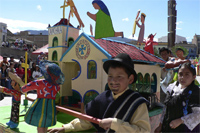Local communities are an inexhaustible source of intangible cultural heritage
Second UNESCO workshop on intangible cultural heritage
Workshop photo gallery

- © UNESCO / Claudio Afanador Hernandez
- Carnaval de Negros y Blancos, Colombia
Putting the emphasis in the relationship with local communities and sharing methods for the rescue, compilation, re-appropriation and use of intangible cultural heritage (ICH) were some of the main topics discussed during this second UNESCO workshop, which took place in Santiago, Chile on November 2 and 3, 2011.
Students from different areas, researchers and academics, government officials and compilers of oral traditions attended the event with the purpose of implementing the Convention for the Safeguarding of Intangible Cultural Heritage, approved by the General UNESCO Conference in 2003. This Convention seeks to safeguard this heritage and respect the inheritance of communities, groups and individuals; to create local, national and international awareness on its importance, and to assist in the international cooperation and assistance on this topic.
The workshop was conducted by Soledad Mujica, an International UNESCO Consultant and expert in intangible cultural heritage in Peru, with vast experience in heritage topics and a former member of the Intergovernmental Committee for the Safeguarding of Intangible Cultural Heritage established by the UNESCO Convention. Mujica presented an introduction to the Convention and spoke about the role of communities its implementation, work plans and community actions, among other things. She also gave examples of local organization for the safeguarding of ICH in Peru and their interaction with government institutions. Mujica gave ideas on how to prepare inventories, explained examples of good practices and delivered recommendations on public policy regarding this topic.
During the workshop, the Directorate of Libraries and Museums of Chile (DIBAM) shared experiences regarding social participation and heritage rescue. On this note, Gloria Elgueta, coordinator of the Memories of the 20th Century Programme of the National Library of Chile, presented the website Memories of the 20th Century (www.memoriasdelsigloxx.cl) which displays photographs, printed and audiovisual material compiled and produced by public libraries and museums in conjunction with local communities.
During her presentation, Elgueta stated that there are many expressions of Chilean intangible heritage that have been poorly cared for or simply destroyed, a situation that represents a great loss for Chilean society. By way of example she pointed out that the “animitas”, a popular expression of religiousness found along roads and highways have been destroyed as the result of modernizing road networks in Chile. “This type of tension is always present in the effort to preserve our heritage”, she stated.
What is Intangible Cultural Heritage? (ICH)
Cultural heritage is not limited to monuments and the collection of objects, but also to the living traditions and expressions inherited from our forefathers and transmitted to our descendents. Examples include oral traditions, performing arts, social usages, rituals, festive acts, knowledge and practices related to nature and the universe, and to the know-how and techniques of traditional handicrafts.
Despite its fragility, intangible cultural heritage is an important factor to maintain cultural diversity in the presence of increasing globalization. Understanding the intangible cultural heritage of different communities contributes to dialogue between cultures and fosters respect towards other ways of life.
The importance of intangible cultural heritage does not lie solely in the cultural manifestation, but rather in the wealth of knowledge and techniques that are transmitted from generation to generation. The social and economic value of this transmission of knowledge is pertinent for both minorities and majorities of a State, and has the same importance for under-developed countries as for those already developed. Intangible cultural heritage is traditional, contemporary and alive at the same time. It integrates communities, representing and emanating from them.
More information:
• Intangible Cultural Heritage, Culture Sector, UNESCO
• Memories of the 20th Century (In Spanish)
- 08-11-2011
- © UNESCO / Claudio Afanador Hernandez - Carnaval de Negros y Blancos, Colombia

